-
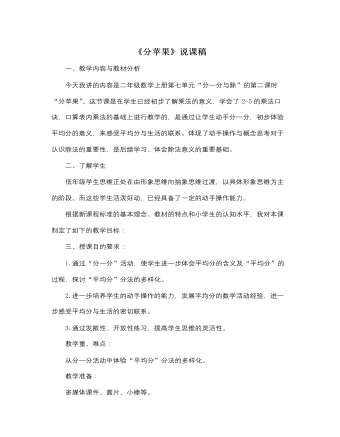
北师大版小学数学二年级上册《分苹果》说课稿
1.故事情境法;2.激励法;3.多媒体辅助法;4.开放式教学法“教是为了不教”,可见教学贵在教给学生学习方法。教学中让学生充分地参与探究,动手实践,讨论交流,获取新知,领悟方法,形成解决问题的能力。五、授课过程为了实现以上教学目标,根据新课程倡导的理念和学生的年龄特征,本节课我以“笑笑过生日”这个故事情境贯穿课的始末,引导学生在“实践”中学习、在“实践”中体验,设计了如下教学流程:1、创设情境、激发兴趣:俗话说:“良好的开端是成功的一半”,而兴趣是学习入门的向导,是激发学生求知欲,吸引学生乐学的内在动力。本节课的导入部分,我创设了这样一个情境,笑笑过生日,请来了许多客人,准备了一袋苹果来招待客人,想让小朋友帮助笑笑来分一分。同学们,现在就请你们用手中的12根小棒代替苹果,动手分一分,看一看这12个苹果你怎么分?这节课,我们就来学习分苹果。(板书:分苹果)

北师大版小学数学三年级上册《0×5=?》说课稿
各位老师大家好。今天我说课的内容是:北师大义务教育课程标准实验教科书小学数学三年级上册《0×5=?》。教材分析:《0×5=?》是三年级上册第四单元的第二个内容。学生先学习两、三位数乘一位数的乘法,然后再发现有关0的乘法规律的基础上学习因数中间或末尾有0的乘法,最后学习连乘。《0×5=?》这部分内容比较抽象,因为一个数和0相乘得0,学生不易理解,容易和加法混淆,乘积怎样写也容易出现错误;几乘0得0后,很容易忘记加进位上来的数。为了分散难点,教材把一个因数中间有0和一个因数末尾有0的乘法安排在学生学会了一位数乘二、三位数的一般运算方法之后进行讲练,这样可使难点分散,便于学生集中精力学习在乘的过程中,0的具体处理方法。学习《0×5=?》,有利于学生完整地掌握整数乘法的计算方法,并为以后进一步学习连乘乃至于学习小数乘法打好基础。
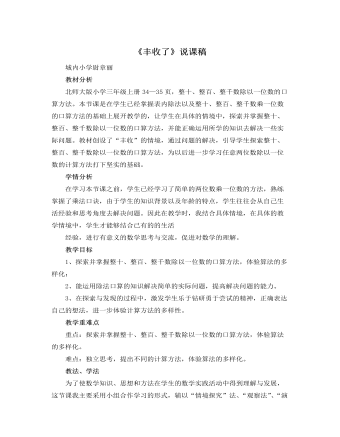
北师大版小学数学三年级上册《丰收了》说课稿
教材分析北师大版小学三年级上册34—35页,整十、整百、整千数除以一位数的口算方法。本节课是在学生已经掌握表内除法以及整十、整百、整千数乘一位数的口算方法的基础上展开教学的,让学生在具体的情境中,探索并掌握整十、整百、整千数除以一位数的口算方法,并能正确运用所学的知识去解决一些实际问题。教材创设了“丰收”的情境,通过问题的解决,引导学生探索整十、整百、整千数除以一位数的口算方法,为以后进一步学习任意两位数除以一位数的计算方法打下坚实的基础。学情分析在学习本节课之前,学生已经学习了简单的两位数乘一位数的方法,熟练掌握了乘法口诀,由于学生的知识背景以及年龄的特点,学生往往会从自己生活经验和思考角度去解决问题。因此在教学时,我结合具体情境,在具体的教学情境中,学生才能够结合已有的的生活经验,进行有意义的数学思考与交流,促进对数学的理解。
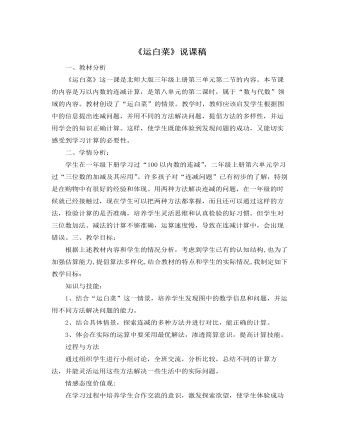
北师大版小学数学三年级上册《运白菜》说课稿
一、教材分析《运白菜》这一课是北师大版三年级上册第三单元第二节的内容。本节课的内容是万以内数的连减计算,是第八单元的第二课时,属于“数与代数”领域的内容。教材创设了“运白菜”的情景。教学时,教师应该启发学生根据图中的信息提出连减问题,并用不同的方法解决问题,提倡方法的多样性,并运用学会的知识正确计算。这样,使学生既能体验到发现问题的成功,又能切实感受到学习计算的必要性。二、学情分析:学生在一年级下册学习过“100以内数的连减”,二年级上册第六单元学习过“三位数的加减及其应用”。许多孩子对“连减问题”已有初步的了解,特别是在购物中有很好的经验和体现。用两种方法解决连减的问题,在一年级的时候就已经接触过,现在学生可以把两种方法都掌握,而且还可以通过这样的方法,检验计算的是否准确,培养学生灵活思维和认真检验的好习惯。但学生对三位数加法、减法的计算不够准确,运算速度慢,导致在连减计算中,会出现错误。
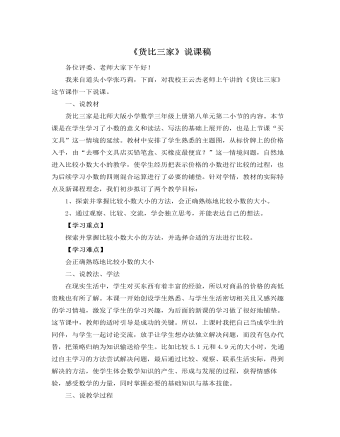
北师大版小学数学三年级上册《货比三家》说课稿
一、说教材货比三家是北师大版小学数学三年级上册第八单元第二小节的内容。本节课是在学生学习了小数的意义和读法、写法的基础上展开的,也是上节课“买文具”这一情境的延续。教材中安排了学生熟悉的主题图,从标价牌上的价格入手,由“去哪个文具店买铅笔盒、买橡皮最便宜?”这一情境问题,自然地进入比较小数大小的教学,使学生经历把表示价格的小数进行比较的过程,也为后续学习小数的四则混合运算进行了必要的铺垫。针对学情,教材的实际特点及新课程理念,我们初步拟订了两个教学目标:1、探索并掌握比较小数大小的方法,会正确熟练地比较小数的大小。2、通过观察、比较、交流,学会独立思考,并能表达自己的想法。
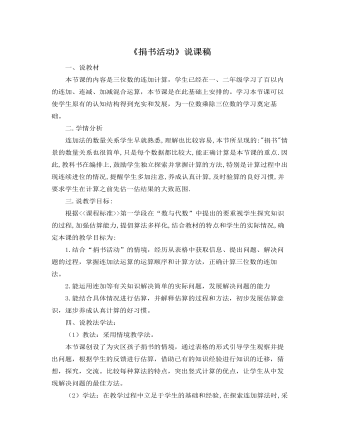
北师大版小学数学三年级上册《捐书活动》说课稿
一、说教材本节课的内容是三位数的连加计算,学生已经在一、二年级学习了百以内的连加、连减、加减混合运算,本节课是在此基础上安排的。学习本节课可以使学生原有的认知结构得到充实和发展,为一位数乘除三位数的学习奠定基础。二.学情分析连加法的数量关系学生早就熟悉,理解也比较容易,本节所呈现的:"捐书"情景的数量关系也很简单,只是每个数据都比较大,能正确计算是本节课的重点.因此,教科书在编排上,鼓励学生独立探索并掌握计算的方法,特别是计算过程中出现连续进位的情况,提醒学生多加注意,养成认真计算,及时验算的良好习惯,并要求学生在计算之前先估一估结果的大致范围.三.说教学目标:根据>第一学段在“数与代数”中提出的要重视学生探究知识的过程,加强估算能力,提倡算法多样化,结合教材的特点和学生的实际情况,确定本课的教学目标为
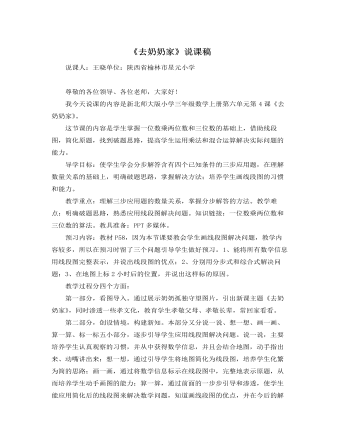
北师大版小学数学三年级上册《去奶奶家》说课稿
我今天说课的内容是新北师大版小学三年级数学上册第六单元第4课《去奶奶家》。这节课的内容是学生掌握一位数乘两位数和三位数的基础上,借助线段图,简化原题,找到破题思路,提高学生运用乘法和混合运算解决实际问题的能力。导学目标:使学生学会分步解答含有四个已知条件的三步应用题,在理解数量关系的基础上,明确破题思路,掌握解决方法;培养学生画线段图的习惯和能力。教学重点:理解三步应用题的数量关系,掌握分步解答的方法。教学难点:明确破题思路,熟悉应用线段图解决问题。知识链接:一位数乘两位数和三位数的算法。教具准备:PPT多媒体。预习内容:教材P58,因为本节课要教会学生画线段图解决问题,教学内容较多,所以在预习时留了三个问题引导学生做好预习。1、能将所有数学信息用线段图完整表示,并说出线段图的优点;2、分别用分步式和综合式解决问题;3、在地图上标2小时后的位置,并说出这样标的原因。

北师大版小学数学三年级下册《吃西瓜》说课稿
二、教学目标的确立教学目标根据学生的年龄特点、教学内容,我确定了如下的教学目标:1.结合解决问题的过程,初步理解同分母分数加减法算理,并能正确计算。2.能用同分母分数的加减运算,解决一些简单的实际问题。3.在动手操作中,激发学生学习兴趣,培养学生合作意识和勇于探索、自主学习的精神。三、教材处理本节课我充分尊重教材,将整节课至于生动的情境中,以观察思考、动手实践、合作交流为主要形式,使学生完成对知识的建构,同时感知数学与生活的联系。根据教学目标及学生的认识规律我确定了:教学重点:理解并掌握同分母分数加减法的计算方法,并能通过运算解决一些简单的实际问题。教学难点:解决“1减几分之几”的问题。四、教法学法教学中我采取“创设情境,自主探索,合作交流”开放式探究模式的教法,引导学生想学、乐学。创造主动参与,积极探究的氛围,让学生以动手操作,动眼观察、动脑思考、同桌互学,小组研讨、集体评论的学法,让学生全程参与到每个教学环节中来。
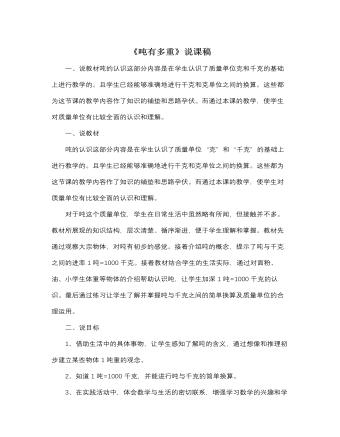
北师大版小学数学三年级下册《吨有多重》说课稿
一、说教材吨的认识这部分内容是在学生认识了质量单位“克”和“千克”的基础上进行教学的。且学生已经能够准确地进行千克和克单位之间的换算。这些都为这节课的教学内容作了知识的铺垫和思路孕伏。而通过本课的教学,使学生对质量单位有比较全面的认识和理解。对于吨这个质量单位,学生在日常生活中虽然略有所闻,但接触并不多。教材所展现的知识结构,层次清楚、循序渐进,便于学生理解和掌握。教材先通过观察大宗物体,对吨有初步的感觉。接着介绍吨的概念,提示了吨与千克之间的进率1吨=1000千克。接着教材结合学生的生活实际,通过对面粉、油、小学生体重等物体的介绍帮助认识吨,让学生加深1吨=1000千克的认识。最后通过练习让学生了解并掌握吨与千克之间的简单换算及质量单位的合理运用。
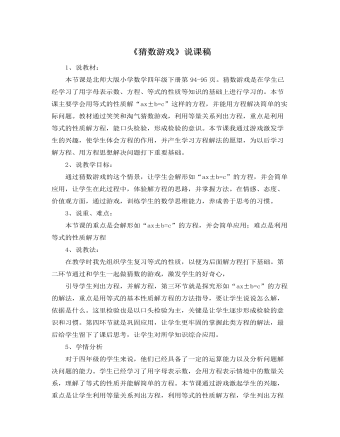
北师大版小学数学四年级下册《猜数游戏》说课稿
1、说教材:本节课是北师大版小学数学四年级下册第94-95页。猜数游戏是在学生已经学习了用字母表示数、方程、等式的性质等知识的基础上进行学习的。本节课主要学会用等式的性质解“ax±b=c”这样的方程,并能用方程解决简单的实际问题。教材通过笑笑和淘气猜数游戏,利用等量关系列出方程,重点是利用等式的性质解方程,能口头检验,形成检验的意识。本节课我通过游戏激发学生的兴趣,使学生体会方程的作用,并产生学习方程解法的愿望,为以后学习解方程、用方程思想解决问题打下重要基础。2、说教学目标:通过猜数游戏的这个情景,让学生会解形如“ax±b=c”的方程,并会简单应用,让学生在此过程中,体验解方程的思路,并掌握方法。在情感、态度、价值观方面,通过游戏,训练学生的数学思维能力,养成善于思考的习惯。3、说重、难点:本节课的重点是会解形如“ax±b=c”的方程,并会简单应用;难点是利用等式的性质解方程
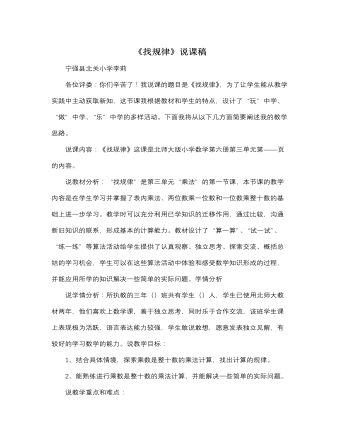
北师大版小学数学三年级下册《找规律》说课稿
(三)、巩固反馈师:同学们的表现真的令我出乎意料,你们太聪明了,今天我就带大家去数学王国去参观,敢去吗?如果你们能闯关成功就可以免费进入王国的游戏宫,有信心吗?(激励学生,让同学们很快进入巩固练习这个环节中来)第一关:逛同学恩喜爱的食品店(这一关的设计采用抢答的方式进行,更进一步激发学生的学习兴趣,而且巩固了本课重点——计算规律。)第二关:我们来到了你们的妈妈喜欢服装店(这一关先让学生独立尝试,并抽生板演,全班订正,注意强调答语的写法。)第三关:现在我们来到了养鸡场。(这一关仍然采用抢答的方式进行,这道题目主要考察同学们对第二条规律的掌握情况)第四关:进入数学王国继续玩抢答游戏和猜一猜活动(这个环节让学生体会到学习的乐趣)
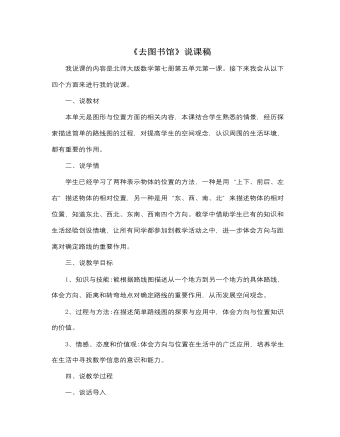
北师大版小学数学四年级上册《去图书馆》说课稿
一、说教材本单元是图形与位置方面的相关内容,本课结合学生熟悉的情景,经历探索描述简单的路线图的过程,对提高学生的空间观念,认识周围的生活环境,都有重要的作用。二、说学情学生已经学习了两种表示物体的位置的方法,一种是用“上下、前后、左右”描述物体的相对位置,另一种是用“东、西、南、北”来描述物体的相对位置,知道东北、西北、东南、西南四个方向。教学中借助学生已有的知识和生活经验创设情境,让所有同学都参加到教学活动之中,进一步体会方向与距离对确定路线的重要作用。三、说教学目标1、知识与技能:能根据路线图描述从一个地方到另一个地方的具体路线,体会方向、距离和转弯地点对确定路线的重要作用,从而发展空间观念。2、过程与方法:在描述简单路线图的探索与应用中,体会方向与位置知识的价值。3、情感、态度和价值观:体会方向与位置在生活中的广泛应用,培养学生在生活中寻找数学信息的意识和能力。
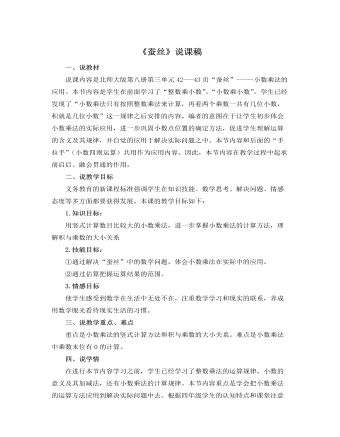
北师大版小学数学四年级下册《蚕丝》说课稿
三、说教学重点、难点重点是小数乘法的竖式计算方法和积与乘数的大小关系。难点是小数乘法中乘数末位有0的计算。四、说学情在进行本节内容学习之前,学生已经学习了整数乘法的运算规律,小数的意义及其加减法,还有小数乘法的计算规律。本节内容重点是学会把小数乘法的运算方法应用到解决实际问题中去。根据四年级学生的认知特点和课堂注意力时间有限的特点,在教学中一定要提高课堂效率五、说教法、学法在本课教学中,我采取的教学方法是:1.通过复习,回顾计算规律,并把它应用到竖式中去。2.情境展示,把数学问题直接放在实际问题中来学习并解决。3.解决问题时采用自主探索、独立思考和小组合作交流的学习方式。通过这些教学法激发学生学习的积极性和主动性,引导学生把学到的规律应用到现实生活中来解决实际问题。六、说教学过程(一)举例说明积的小数位数与乘数小数位数的关系。通过比眼力,做一做,复习前一节课所学内容,为本节课打下基础。

人教版高中英语必修2The Olympic Games说课稿2篇
Purpose of my design:To ask the students to do these two tasks will make the Ss predict the story of this passage. As a result, it will deepen Ss’ memory of this story because they will have their own understanding of this story.Step 3. While-readingTask 1. (Individual work _____min)Skimming: ask students to skim the text and the main ideas of each paragraph in this passage. Please read it quickly and then match the sentences with the letters.Task 2. (Individual work _____min)Scanning: read the text quickly and decide the whether the following statements are true or false and give reasons.Task 3. (Pair work _____min)Listen to the tape and fill in the banks. Then read the paragraph with expression to your partner.Task4 (individual work min)Listen to the tape again and write down the main idea in one sentence.Purpose of my design: Enable students to understand the given material better by using different reading skills. And proper competition can arouse the Ss’ interest in English learning. “Task-based” teaching method is used here todevelop the Ss’ ability of communication and also their ability of co-operation will be well trainedStep 4. Post-readingTask 1. (Individual work, pair work, group work, class work; _____min)Discussion (group of 4):1. If you were Hippomenes, would you run against Atlanta?2. Do you think Hippomenes deserved to win the race? Why or why not?Step 5. HomeworkPlease read the story again carefully after class and imagine: What will happen during the race between Hippomenes and Atlanta? Who do you think will win the race? Do you think Atlanta would marry Hippomenes? Write an end for the story with thses questions.Purpose of my design: Homework is so important and necessary for to master the knowledge they learned after class. It will check whether the Ss achieve the teaching aims.Part 5 Blackboard design

人教版高中英语必修2Wildlife Protection说课稿3篇
When it comes to the students’ studying methods, I'd like to introduce my Ss first. The Ss have a good command of basic language points. They’re interested in learning English, and they take an active part in English class, so they will have fun in autonomous, cooperative and inquiry learning. I will just serve as a guide, showing them the way to explore how to make more progress in their English learning.Now it’s time for the most important stage of this lesson. My teaching procedures are arranged as follows:Step1.Leading-in (3 minute)Play a video of a wide variety of wildlife to introduce my topic. Step2. Speaking (12 minutes)We will use our textbook Page25. Let the Ss fast read the short paragraph to warm up. Ask them to talk about the report on some endangered wildlife in China with the dialogue patterns on the screen. Lastly, I will invite some groups to demonstrate their dialogues about saving wildlife in China.Step3.English play (3 minutes)Watch another video in praise of their excellent performance just now. It’s about Jack Chen’s(成龙)and Yang Ziqiong’s wildlife protection.Step4. Listening (twice 13 minutes)This time, I’ll ask the Ss to fill in the blanks of the monologue of the 2 movie stars above. Step5.Discussion (3 minutes)Which would you like to choose to wear, clothes made of cotton, artificial leather or animal skins? Why ?Step6. Summary (3 minutes)1. If there were no wildlife, there wouldn’t exist human beings. If the buying stops, the killing can, too.2. Animals are our friends. To love animals is to love ourselves. Stop hunting, killing and destroying wildlife.3. Let’s live in harmony with all the living things in the world. Step7. Music appreciation (3 minutes)Let the Ss appreciate the song Earth Song by Michael Jackson. Last but not the least, I will show you my blackboard design.

人教版高中英语必修3Canada-the true north说课稿4篇
Good afternoon, teachers, It’s my great pleasure to be here sharing my lesson with you.The content of my lesson is Senior English Book 3 Unit 5 Canada —— “The true North”.I’ll be ready to begin this lesson from five parts. Analysis of the teaching material,the teaching methods,the studying methods, the teaching procedure,and Blackboard design.First, let me talk about the teaching material.Part 1 Teaching Material:This unit is about the introduction of Canada. By studying of this unit,we’ll enable the students to learn the geography, population, main cities, and natural beauty, natural resources of Canada. Through the training of the unit, it also requires students to learn some Language skills such as the expressions of position and emotions.So it plays an important part in the English teaching in this book.After studying the teaching material and analyzing the rule of children’s growing of mind,I think the teaching aims are the followings:1.Knowledge objects:(1) make the students learn some new words and phrases(2) make the students understand the content of the lesson.2.Ability objects:(1)To develop the Ss’ abilities of listening, speaking, reading and writing. Especially reading and speaking ability.(2) learn to talk about the characters of Canada in English(3)To train the Ss’ ability of working in pairs.3.Emotion objects:(1)Enable students to understand the characters of Canada..(2)Stimulate Ss to work hard to make China stronger.Part 2 Teaching Methods:I think helping students learn to master new words and phrases and improve the students’ reading and speaking ability is import and the difficult.According to the analysis of the teaching material and the import points and the difficult points,I will use the following teaching methods : question-guiding approach; fast-reading and careful reading; multi-media teaching methods; discussion

人教版高中英语必修3Festivals around the World说课稿3篇
Teaching plan for Unit 1 book3Good morning, teachers. It’s my great pleasure to be here because I can share my lesson with you and I can learn a lot from it. I’ll begin my lesson from the following four parts, the teaching material, the teaching methods, the studying methods and the teaching procedure.Firstly, let me talk about the teaching material. The content of my lesson is the reading passage festivals and celebrations of Unit 1 Festivals around the world. This passage is about festivals and celebrations. By studying this passage, we’ll enable the students to know that festivals exit everywhere, and many of festivals in different countries celebrate similar ideas. As we all know, the reading passage is the center of each unit. If the Ss can learn it well, it will be helpful to make the Ss learn the rest of this unit.After studying the teaching material, I think the teaching aims are as the followings:1. Knowledge aims:(1) The Ss can master the usage of the important words andexpressions.(2)The Ss can use the __________________ (grammar) in the proper situation.Make students know about the festivals all over the world and the detail of the festivals, such as origin, content, and the date of the holiday festivals.2. Ability aims:(1) Students can talk about festivals and celebrations in English(2) To improve the student’s reading ability, especially their skimming and scanning ability.3. Emotion aims:Make the Ss know about the foreign festivals, and respect other countries’ custom.Next, let’s come to the important points and the difficult points.The important point is how to make the Ss understand the text better and the difficult point is how can they talk about it. secondly, Teaching Methods:1. task-based Language Teaching2. Computer assisted language teaching.3. question-and–answer methodThirdly, Studying Methods:

人教版高中英语必修3Healthy Eating说课稿4篇
Language learning needs a context, which can help the learners to understand the language and then can product comprehensible output, so computer has the advantages to make the materials attractive.Part 3 Learning MethodsTask-based, self-dependent and cooperative learningPart 4 Teaching ProcedureStep One Lead-in“Interest is the best teacher.” Therefore, at the very beginning of the class, I should spark the students’ mind to focus on the centre topic “the band”. I’ll show some pictures of food to attract their attention and then bring some questions.Question:What kind of food they like?What should go into a good meal?The answers must relate to the diet. After this, the students will be eager to know something about a balance diet and this is the very time to naturally lead the class into Step 2Step 2 Reading for information: skimming and scanning In this step, I use Task-based Language Teaching method, which can give students a clear and specific purpose while skimming and scanning the context.Task 1 General ideaThe students will be asked to just glance at the title and the pictures of the passage, and then guess what they will read in the text. And they’ll be divided into groups of four to have a discussion.The purpose is to inspire the students to read actively, not passively. In addition, the task is to develop the students’ reading skill by making prediction and to encourage the students to express their thoughts in English and cooperate with each other.Task 2 Main idea of each paragraphCooperative learning can raise the students’ interest and create an atmosphere of achievement. Based on this theory, I divide the whole class into 4 groups to skim the whole text and get the main idea of each paragraph.

人教版高中英语必修3The million pound bank note说课稿3篇
在接下来的细读环节,我套用了高考对阅读理解的考查方式设置了5个问题,分别为三个推理判断题,一个细节题和一个主旨大意题。学生需要对文章的内容进行分析、归纳、推理、猜测等高级思维活动才能做出正确的回答。【设计意图】这一过程是对学生进行细读的训练,培养学生获取特定信息和挖掘文章深层次信息的能力。第三环节:Intensive-reading (精读) 15′第三个环节精读,既是最重要的环节,也是突破本课重难点的关键。首先,让学生思考剧本中人物看到百万英镑前后的态度发生了怎样的变化。其次,让学生仔细阅读文章,找出可以表现人物态度变化的具体的语言和动作。最后,让学生总结人物的态度发生变化的根本原因是什么,从而引出Money Talks, 供学生思考。【设计意图】通过一系列的活动培养学生学习从人物的语言和动作探究人物的心理,使学生进一步体会戏剧语言的魅力,从而对文章背后所反映的社会问题进行思考,也为下一步的讨论环节做好铺垫。

人教版高中英语必修5Great scientists说课稿4篇
通过写文章梗概,培养学生综合运用语言的能力,学习用恰当的英语描述科学家的故事。这是本课的教学难点。教师可以使用完形填空的方式来帮助学生整理语篇,从而来降低难度。本课的教学重点的突破方法是:在阅读前,让学生初步了解得出科学观点所需要的基本程序,从而轻松而自然地导入文章的阅读;在阅读过程中,由易到难设计快速阅读和精读的问题,层层推进各种阅读活动,让学生对阅读内容从整体感知到细节理解,最后深层读懂整篇文章,同时加强阅读策略的指导,让每个学生都主动参与课堂教学活动,最终达到提高阅读能力的目的。Step 4 Post-readingGroup Activities四人小组共同合作,在老师的适当指导下,就以下2个问题展开讨论,让学生就所知、所学、所感和所想融入话题,然后抽若干同学代表作小组发言。1. What do you think about John Snow, and what should we learn from him?2. Cholera was 19th century disease, which two diseases are similar to cholera today? Why?

